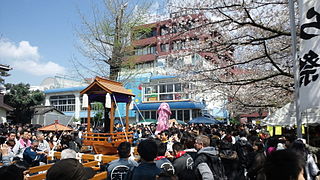 W
WThe Aoi Matsuri (葵祭), or "Hollyhock Festival," is one of the three main annual festivals held in Kyoto, Japan, the other two being the Festival of the Ages and the Gion Festival. It is a festival of the two Kamo shrines in the north of the city, Shimogamo Shrine and Kamigamo Shrine. The festival may also be referred to as the Kamo Festival. It is held on 15 May of each year.
 W
WFukagawa Matsuri or the Fukagawa Festival, is one of the three great Shinto festivals of Tokyo, along with the Kanda Matsuri and Sannō Matsuri.
 W
WThe Gion Festival takes place annually during the month of July in Kyoto and is one of the most famous and largest festivals in Japan. It's formally part of Japan's indigenous, nature-based Shinto faith, and its original purposes were purification and pacification of disease-causing entities. There are many ceremonies held during the festival, but it is best known for its two Yamaboko Junkō (山鉾巡行) processions of floats, which take place on July 17th and 24th. Many festival events take place in the historic kimono district in central Kyoto, and at the Yasaka Shrine. The Shinto Yasaka Shrine is the festival's patron shrine. It's located in Kyoto's famous Gion district, which gives the festival its name.
 W
WThe Great Festival of Fujisaki Hachimangu Shrine is a festival of Fujisaki-hachimangu at Chūō-ku, Kumamoto every September, characterized by a parade of Shinto priests, followed by groups of followers who chase their horses shouting, "Boshita, Boshita", in earlier times; but now the parade followers, "Dookai Dookai", or other phrases. Recently 17,000 people participated in this festival.
 W
WThe Jidai Matsuri is a traditional Japanese festival held annually on October 22 in Kyoto, Japan. It is one of Kyoto's renowned three great festivals, with the other two being the Aoi Matsuri, held annually on May 15, and the Gion Matsuri, which is held annually from 17 to July 24. It is a festival enjoyed by people of all ages, participating in its historical reenactment parade dressed in authentic costumes representing various periods, and characters in Japanese feudal history.
 W
WThe Shinto Kanamara Matsuri is an annual Japanese festival held each spring at the Kanayama Shrine in Kawasaki, Japan. The exact dates vary: the main festivities fall on the first Sunday in April. The phallus, as the central theme of the event, is reflected in illustrations, candy, carved vegetables, decorations, and a mikoshi parade. The shrine is part of the Wakamiya Hachimangu Shrine and located near Kawasaki-Daishi Station.
 W
WKanda Matsuri (神田祭) or the Kanda Festival, is one of the three great Shinto festivals of Tokyo, along with the Fukagawa Matsuri and Sannō Matsuri. The festival started in the early 17th century as a celebration of Tokugawa Ieyasu's decisive victory at the battle of Sekigahara and was continued as a display of the prosperity of the Tokugawa shogunate during the Edo period. Additionally, the current form of the festival is also held in honor of the kami of Kanda Myōjin.
 W
WSanja Matsuri , or Sanja Festival, is one of the three largest Shinto festivals in Tokyo. It is considered one of the wildest and largest. The festival is held in honor of Hinokuma Hamanari, Hinokuma Takenari, and Hajino Nakatomo, the three men who established and founded the Sensō-ji Buddhist temple. Sanja Matsuri is held on the third weekend of every May at Asakusa Shrine. Its prominent parades revolve around three mikoshi, as well as traditional music and dancing. Over the course of three days, the festival attracts 1.5 to 2 million locals and tourists every year.
 W
WSannō Matsuri (山王祭) or the Sannō Festival, is a major Shinto festival in Tokyo, along with the Fukagawa Matsuri and Kanda Matsuri. The Festival takes place annually in mid-June, but involves a procession called Shinkosai in even-numbered years only; annual celebrations encompass a number of activities and celebrations over a week, including the day-long Shinkosai parade through Nagatachō, Chiyoda, Tokyo.